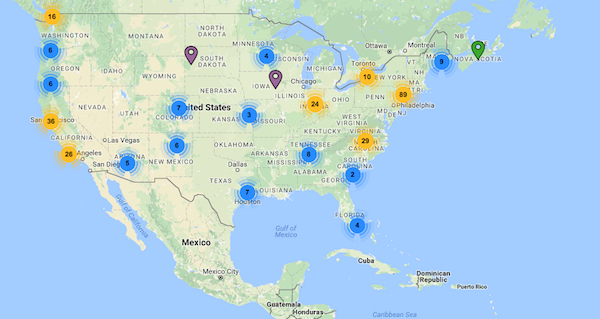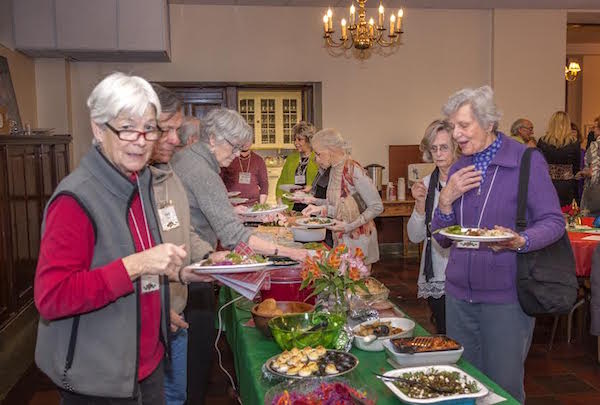Back in 2011, Shareable covered the budding senior village movement. The villages, of which there were only a handful at the time, offer seniors a safety net — members can live independently, while having the option to call people for help with any number of tasks, from getting a ride to the doctor to having a lightbulb changed in their home. While some of these villages have a paid staff member to run these errands, many are run by volunteers, which often includes the residents themselves.
We spoke with Natalie Galucia, executive director of the Village to Village Network, an organization based in St. Louis, Missouri, that helps communities establish and manage their own senior villages. Galucia says there are now 215 open villages and 130 others in development — most are in the U.S., but there are some in Canada, Australia, and the Netherlands.
Cat Johnson: What have you seen from the senior village movement in the last five or so years?
Natalie Galucia: It's really grown. Five years ago there were just a handful. [Now] villages are currently in 44 states and the District of Columbia. They're heavy on the coasts then scattered throughout the country. We've recently added villages in Oklahoma and Iowa, and there's more interest in midwestern states.
We're celebrating the 15th anniversary of the village model and the first senior village, Beacon Hill Village in Boston. As the village model gets older, it is really changing and growing and adapting. Communities are changing and the wants and needs of older adults are changing. Especially as more boomers are getting involved, we're seeing more innovative programming and the overall mission of the villages. It's starting to grow from just impacting the members, to really wanting to provide impact throughout the entire community.
What are some examples of the community-focused programming?
A lot of villages are getting more involved with Age Friendly Community initiatives. A couple of villages have even kicked off those initiatives. For instance, in Columbus, Ohio, villages there are getting together and pushing it through the mayor to make that happen. Villages are also getting involved in intergenerational programming — putting on programming that involves kids, whether it's kids volunteering to help older adults that are members of the village or members of the village volunteering to provide some type of mentorship to kids in the community.
How has the general village model changed in recent years?
Villages are finding ways to diversify revenue. Local governments are providing more support as they realize the importance of senior villages. City support is only in a few areas so far, including San Francisco, but we're really hoping this trend will continue. Two counties, Montgomery County in Maryland and Fairfax County in Virginia both have either a part-time or full-time staff person that's the village liaison to provide information for villages that are starting and provide additional support and funding for operating villages.
Another model that's been emerging is the hub and spoke model where one village acts as the hub and has the 501(c)3 status. They offer all the back office support with things like computer system and database management. Examples of this model are the Marin Villages in Marin, California, and Villages Northwest outside of Portland, Oregon.
The hubs then provide support and cost sharing to localized spokes of the village. Each neighborhood or surrounding city might have their own spoke, then they all work together to help spread out the resources. By doing that, it helps them all keep their costs down. Each spoke still has their own members and their own volunteers and they might put on their own programming, as well as some events or more hub and spoke things. They have the unique identity of the town or neighborhood but then have the overall broad umbrella identity of the entire organization. I'll think we’ll continue moving along on this trend as we grow.

There are now 215 senior villages, with 130 more in the works. Map: Village to Village Network
For those interested in joining a village, what's the best way? What's the first step?
The best way is to check our website where there's an interactive village map with multiple search options to search by city or state. There's additional contact information if people want to get in touch directly, or they can also reach out to use and we’ll connect them to the local village.
If someone doesn't have a village in their town, how can they start one? What are the first few steps?
Get on the website and explore the villages to learn more about the model. See what resources are available, connect with a village that might be somewhat close to your area, [and] see what other interest there is in your area. Are there other individuals interested in doing this? Are there existing nonprofits or organizations you can partner with? Is the local government interested? Start to gauge that interest.
This is not a one-person job so the more support you can get up-front, the better. Start thinking through what your village might look like. What's already available in your community? What's lacking?
Early partnerships are really important. Even if they're not directly involved with starting the village, just plant a bug in their ear and see what kind of resources they could help provide. In return, see if there’s something the village can give back to them.
What makes a successful senior village? What are some tips to help it thrive?
They key is building up that strong sense of community. That's what really sells people on the concept and idea. Some communities still do that well, but I think we're starting to lose that. Whether people move or just get busy, that can be harder to come by. I talked to a couple villages recently that don't have as strong a sense of community as they would like. They're trying to build it up by letting their members know that they have a community and a network of support, not just a ride to the doctor, but someone to talk to or lend a helping hand.
Aging in place is a really great concept, but it can be isolating. If you don't have children or other family living near you having someone to check in on you, or bring your groceries once a week, or make sure you're getting out of the house and participating in things, can be an important piece of this.
Are there other challenges senior villages face? If so, how are they being addressed?
Broader sustainability of the village model is the biggest challenge, especially revenue and revenue diversification. Villages are really trying to keep their membership affordable. Membership only covers 40-60 percent of their revenue so they have to figure out how to fill in the gaps.
Being more for-profit business minded when it comes to building partnerships and bringing in different revenue streams is really important. We're looking at, and focusing more on, what some of those other models for nonprofits or associations are. We can help educate our villages about resources we can provide and partnerships we can provide that might trickle down to them and bring more sustainability to the movement as a whole.
What other tips can you offer for those interested in joining the senior village movement?
Even if you're just exploring the idea of a senior village, we have an introductory membership that’s $100 for six months. It gives 10 people in your community access to all our resources, including the Village 101 Toolkit and our discussion forum, to see what’s there and what this is all about. You can start exploring in your community and see what might be needed.
Header photo by STL Village. Follow @CatJohnson on Twitter









